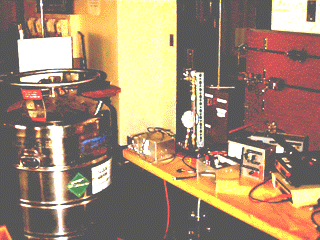|


The Meisner effect; persistent
currents; the Josephson effect. Several of the
phenomena of superconductivity are observed in
three experiments carried out in a liquid helium
cryostat. The transition to the superconducting
state of each of several bulk samples of Type
I and II superconductors is observed in measurements
of the exclusion of magnetic field (the Meisner
effect) from samples as the temperature is gradually
reduced by the flow of cold gas from boiling helium.
The persistence of a current
induced in a superconducting cylinder of lead
is demonstrated by measurements of its magnetic
field over a period of a day. The tunneling of
Cooper pairs through an insulating junction between
two superconductors (the DC Josephson effect)
is demonstrated, and the magnitude of the fluxoid
is measured by observation of the effect of a
magnetic field on the Josephson current.
Student Wiki: Superconductivity
Download
Lab Guide in PDF format
(certificates
required)

- [1935] F. London and H. London, "The
Electromagnetic Equations of the Supraconductor", Reprinted from
Proc. Roy. Soc., Vol. A149, pp. 71-88, (1935)
- [1954] H. E. Bommel,"Ultrasonic
Attenuation in Superconducting Lead", Physical Review, Vol. 96,
No. 1, October (1954).
- [1956] W. S. Corak, B. B. Goodman, C. B. Satterwaite, and A. Wexler, "Atomic
Heats of Normal and Superconducting Vanadium", Physical Review,
Vol. 102, No. 3, May (1956).
- [1957] J. Bardeen, L. N. Cooper, and J. R. Schrieffer, "Theory
of Superconductivity", Physical Review, Vol. 108,
No. 5, pp. 1175-1204, (1957).
- [1957] J. W. Crowe,"Trapped-Flux
Superconducting Memory", Reprinted from IBM J. Res. Develop.,
Vol. 1, pp. 295-303, (1957).
- [1960] L. N. Cooper, "Theory
of Superconductivity", American Journal of Physics,
Feb, pp. 91-101, (1960)
- [1961] J.E. Kunzler, E. Buehler, F.S.L. Hsu, and J.H. Wernick,"Superconductivity of Nb3Sn at High Current Density in a Magnetic Field of 88 kGauss", Phys. Rev. Letts, 6, no.3, pp. 89-91, (1961).
- [1962] Nobel
Prize Lecture for Lev Davidovic Landau <<for his pioneering
theories for condensed matter, especially liquid helium>>
- [1964] D. M. Ginsberg, "Resource
Letter Scy-1 on Superconductivity", American Journal of Physics,
Vol. 32, No. 2, Feb (1964).
- [1964] Superconductivity:
Selected Reprints, AIP
- [1965] R. P. Feynman, Feynman Lectures on Physics, (Reading, MA,
Addison-Wesley, 1965), "A
Seminar on Superconductivity", Vol III, Chap. 21.
- [1965] R. D. Parks, "Quantum
Effects in Superconductors", Scientific American,
Vol. 213, No. 4, pp. 57-67, October (1965).
- [1972] Nobel
Lecture for John Bardeen, Leon N Cooper and J Robert Schrieffer
<<for their jointly developed theory of superconductivity, usually
called the BCS-theory>>
- [1973] J. Bardeen,"Electron-phonon
interactions and superconductivity", Physics Today,
Vol. 26, pp. 41-46, (1973)
- [1973] Nobel
Lectures for Leo Esaki and Ivar Giaever <<for their experimental
discoveries regarding tunneling phenomena in semiconductors and superconductors
respectively>>
and Brian D Josephson <<for his theoretical predictions of the
properties of a supercurrent through a tunnel barrier, in particular those
phenomena
whichare generally known as Josephson effects>>
- [1973] L. N. Cooper, "Microscopic
quantum interference in the theory of superconductivity", Physics
Today, Vol. 26, pp. 31-39, July (1973).
- [1973] J. R. Schrieffer, "Macroscopic
quantum phenomena from pairing in superconductors", Physics Today,
Vol. 26, pp. 23-28, July (1973).
- [1975] Tinkham "Introduction
to Superconductivity" (151 pages)
- [1986] Possible High Tc Superconductivity in the Ba-La-Cu-O SystemJ. Bednorz and K. Muller, Z. Phys. B - Condensed Matter 64, pp. 189-193

- [1963] Josephson, B.D., "Coupled Superconductors", pp. 216-220, Reviews of Modern Physics, Vol. 36, No. 1
- [1963] Observation
of Josephson effect and Measurement of e/h
in Adventures in Experimental Physics
- [1966] Langenberg, D.N., Scalapino, D.J., and Taylor, B.N., "The
Josephson Effects", pp. 30-39, Scientific
American, Vol. 214, No. 5, May (1966)
- [1968] Richards, P.L., Shapiro, S., and Grimes, C.C., "Student Laboratory Demonstration of Flux Quantization and the Josephson Effect in Superconductors", American Journal of Physics, pp. 690-697, Vol. 36, No. 8, August (1968)
- [1970] Clarke, J., "The
Josephson Effect and e/h", pp. 1071-1092,
American Journal of Physics, Vol. 38, No. 9,
September (1970)
- [1970] Scalapino, D.J., "Josephson Effects" in Encyclopedia of Physics, Edited by Lerner and Trigg, pp. 479-481
- [1989] Bruynseraede, Y., Vlekken, C., and Van Haesendonck, C., "Giaever and Josephson Tunneling", NATO ASI Series, Vol. F59, Superconducting Electronics, Springer-Verlag (1989)

- Spec
Sheet for DT-470 and DT-471 Silicon Diodes (Lakeshore)
- Taconis Oscillations
- Model 1900 Temperature Indicator
- Probe I Si-diode (DT-470) calibration: Voltage and Temperature
|